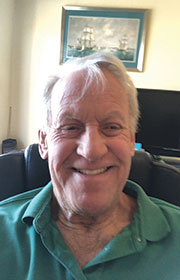The Environmental Health Engineer
Fall
2022
Spotlight on Hidden Physicists
The Environmental Health Engineer
Tom Jenckes, Research and Development Department, Pacific Gas & Electric Co., and Associate Professor of Business, Argosy University (Retired)
 In high school I avoided the “hard” sciences, but I enlisted in the US Navy nuclear submarine program in 1960. It required three years of college-level sciences, and for that I was sent to Nuclear Power Training School in New London, Connecticut, where I learned that I could do physics, chemistry, and higher math. Then it was on to a nuclear power submarine training facility in Windsor Locks, Connecticut. While stationed there I went to night school at the University of Hartford and majored in electrical engineering. After two years I was sent to the submarine USS Skate (SSN-578). Within six months the Skate entered the Norfolk Naval Shipyard for refueling. While there, I continued my education at Old Dominion College and signed up for a prerequisite Physics 101 course.
In high school I avoided the “hard” sciences, but I enlisted in the US Navy nuclear submarine program in 1960. It required three years of college-level sciences, and for that I was sent to Nuclear Power Training School in New London, Connecticut, where I learned that I could do physics, chemistry, and higher math. Then it was on to a nuclear power submarine training facility in Windsor Locks, Connecticut. While stationed there I went to night school at the University of Hartford and majored in electrical engineering. After two years I was sent to the submarine USS Skate (SSN-578). Within six months the Skate entered the Norfolk Naval Shipyard for refueling. While there, I continued my education at Old Dominion College and signed up for a prerequisite Physics 101 course.
My professor had just completed his physics doctorate at the College of William & Mary. Boy, did he ever open my eyes to all the wonderful facets of physics! He instilled in me an excitement for physics that changed my path. When I was discharged from the Navy, I went to the University of Rhode Island (URI) to complete my bachelor’s degree, which I did in two years.
At URI I served as president of the Society of Physics Students. While in this role, I arranged field trips for the group. One trip took us to the US Food and Drug Administration (FDA) lab in Natick, Massachusetts, where we observed techniques for irradiating food to prolong shelf life. That’s where I learned of a master’s program in health physics at Temple University. I applied and began the program, which was sponsored by the US Public Health Service, in September 1969. Opportunities opened up, and I was able to garner fellowships to continue my studies at Temple. That field trip to the FDA lab opened up a career for me.
Once I completed my doctorate in environmental health, I worked at Metropolitan Edison in Reading, Pennsylvania. In 1978 I became a supervisor in the radiation safety and environmental engineering group at the Pacific Gas & Electric Company (PG&E). There were four of us initially. Our main responsibility was to procure an environmental technical specifications license for PG&E from the Nuclear Regulatory Commission (NRC). We were excited to have such an important role and hired top-notch consultants to ascertain the environmental impacts of our unit. My physics training prepared me to take on this huge endeavor, and a year later our company received an environmental operating license from the NRC! People from other power companies came to see how we accomplished such a big job in such a short time.
The culmination of my career was designing the research and development program at PG&E, which I was able to develop thanks to the physics skills I learned. My advice to physics students: Think big! Physics trains you to have broad horizons.
